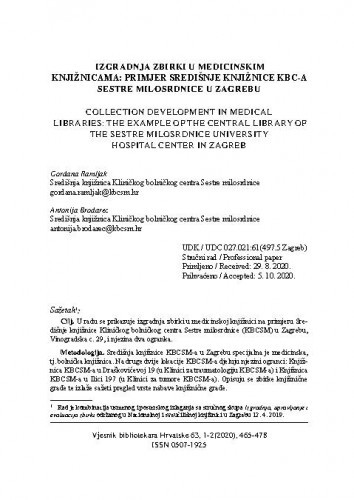Cilj. U radu se prikazuje izgradnja zbirki u medicinskoj knjižnici na primjeru Središnje knjižnice Kliničkog bolničkog centra Sestre milosrdnice (KBCSM) u Zagrebu, Vinogradska c. 29 i njezina dva ogranka. Metodologija. Središnja knjižnice KBCSM u Zagrebu. specijalna je medicinska tj. bolnička knjižnica. Na druge dvije lokacije KBCSM djeluju njezini ogranci: Knjižnica KBCSM u Draškovićevoj 19 (u Klinici za traumatologiju KBCSM) i Knjižnica KBCSM u Ilici 197 (u Klinici za tumore KBCSM). Opisuju se zbirke knjižnične građe te izlaže sažeti pregled vrste nabave knjižnične građe. Rezultati. Zbog prirode biomedicinskih informacija koje zastarijevaju jako brzo, za formiranje zbirki najznačajnije su zbirke periodike, baze podataka te zbirke stranih i domaćih knjiga, koje se redovito nadopunjavaju recentnim izdanjima. Početkom 21. stoljeća u biomedicini sve važnije mjesto zauzimaju e-izvori. Središnja knjižnica KBCSM izgrađuje svoje zbirke kroz nabavu tiskanih i e-izvora vlastitim sredstvima u kombinaciji s pristupom u e-izvore, koji se nabavljaju za znanstvene i akademske ustanove u RH. Vrijednost rada. U radu se zaključuje da Središnja knjižnica KBCSM izgradnjom svojih zbirki na način opisan u ovom radu, uspješno ispunjava temeljnu zadaću velike bolničke knjižnice, a to je potpora stručnom, znanstveno-nastavnom i istraživačkom radu djelatnika KBC Sestre milosrdnice, ali i vanjskih korisnika.; Aim. The paper describes collection building in a medical library using the example of the Central Library of the Sestre milosrdnice University Hospital Center (SMUHC) in Zagreb and its two branch libraries. Methods. The Central Library of the SMUHC at 29 Vinogradska Street in Zagreb is a special medical, i.e. a hospital library. The branch libraries are located at the other two locations of the SMUHC: at 19 Draškovićeva Street (at the Traumatology Department of the SMUHC), and at 197 Ilica Street (at the Oncology Department of the SMUHC). The paper describes the library collections and presents a brief overview of acquisition models. Findings. Due to the nature of biomedical information that becomes out of date rather quickly, the most important collections are periodicals, databases, and collections of the foreign and domestic books, which are regularly updated with the most recent editions. At the beginning of the 21st century, e-resources are becoming increasingly important in biomedicine. The Central Library develops its collections of the printed and e-resources combining the purchase with their own funds and using the access to e-resources procured for the scientific and academic institutions in the Republic of Croatia. Value. It may be concluded that by building its collections in the manner described in this paper, the Central Library of the SMUHC successfully fulfills the basic task of the large hospital library, which is to support the professional, scientific and research work of the employees of the Sestre milosrdnice UHC, as well as of the external users.
Sažetak

 Vjesnik bibliotekara Hrvatske : 63,1-2(2020) / glavna i odgovorna urednica, editor-in-chief Kornelija Petr Balog.
Vjesnik bibliotekara Hrvatske : 63,1-2(2020) / glavna i odgovorna urednica, editor-in-chief Kornelija Petr Balog.